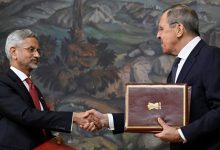
The Biden administration has publicly disclosed sensitive details of a potential UAV sale to New Delhi, drawing the interest of its hostile neighbors
By Neeraj Rajput, New Delhi-based defense journalist and author, editor-in-chief of Hindi digital platform ‘Final Assault’
MQ-9B SkyGuardian © ga-asi.com
Indian Army Chief Gen. Manoj Pande concluded a four-day visit to the US on Friday. During the trip, he held high-level talks with his American counterpart Gen. Randy George and other senior military officials, visited I Corps Headquarters at Joint Base Lewis-McChord (JBLM) and was briefed about the Stryker Unit (Infantry Combat Vehicle) which has been offered by the US for co-manufacturing in India.
But a big question hangs in the air. Many in Indian defense circles are questioning whether New Delhi will be wiling to get into another military sale in the wake of a much-touted, and now well-known, MQ-9B Sky Guardian drones deal.
The US announced earlier this month that Congress had been notified of the potential sale of the UAV, a version of the Predator drone, to India, estimated at around $3.99 billion. It can not be said conclusively if Gen Pande has raised the MQ-9B issue with India’s US partners as the final statement from both sides is yet to be released, however, the announcement of the deal by Pentagon has irked India.
The US Defense Security Cooperation Agency (DSCA) released a statement on February 1 that the State Department had approved a possible deal, which includes the sale to India of 31 MQ-9B Sky Guardian UAVs and other weapons and electronics, spare parts and accessories. The Indian public sphere went into a frenzy. Indeed, the South Asian nation would be finally getting the most lethal combat drones in the world, deployed during the Afghanistan war and for targeting top ISIS and Al Qaeda leadership.
According to the Pentagon, “the proposed sale will improve India’s capability to meet current and future threats by enabling unmanned surveillance and reconnaissance patrols in sea lanes of operation.”
However, authorities in the Indian defense and security establishment were rattled by the official statement, according to sources familiar with the situation. This is largely because the statement not only disclosed which missiles, bombs, radars, and other related military equipment are part of the MQ-9B deal but also the exact numbers to be delivered.
Read more
According to the US statement, the whole MQ-9B RPA deal consists of 31 MQ-9B Sky Guardian aircraft, 170 Hellfire missiles, 310 Laser Small Diameter Bombs, 161 Embedded Global Positioning & Inertial Navigation Systems, and other related equipment. Even the number of training missiles (16) and laser bombs (8) were also mentioned, besides the radars, transponders, IFF (Identification of Friend and Foe), radio sets, and terminals.
While it has been noted that US military sales announcements generally contain such details, this is not the case for every defense deal. The US has a pick-and-choose policy when it comes to disclosing information about weapons and military equipment, depending on its relations with the country involved. This US ‘double standard’ has kept Uncle Sam away from India for a long time, offering one hand for a strong relationship but snubbing the other hand soon after.
To be sure, it is not the first time India has suffered this snub from the US. Post the 1965 war with Pakistan, the US had stopped all arms supplies to India, which had begun soon after the ‘62 war debacle against China. That was the period when India turned towards the Soviet Union (and now Russia) for its defense needs.
The announcement of the drone deal with Washngton coincided with media reports suggesting the US might stall the deal due to ongoing diplomatic issues involving pro-Khalistan movement activist Gurpatwant Singh Pannun, based in the US. The Pro-Khalistan movement is active in both Canada and the US, as well as in the UK and several other countries with large Sikh populations. New Delhi has on many occasions raised concerns with its partners in the West over the “freedom” given to activists in their countries despite their alleged threats to public figures in India, including to Prime Minister Narendra Modi.
Read more
The country’s ties with Canada and the US encountered severe turbulence last year when the Canadian prime minister linked “Indian agents” to the killing in British Columbia last June of prominent Sikh separatist Hardeep Singh Nijjar, sparking a diplomatic rift, in particular between Ottawa and New Delhi. Two months later, a US court indictment alleged that an Indian government official was involved in an assassination attempt against Pannun that had been foiled by the FBI. While New Delhi dismissed the Trudeau government’s allegations as “absurd” and “motivated,” and demanded that Ottawa provide evidence, in the case of Pannun the Indian government formed a high-level committee of investigation.
The sale of 31 MQ-9B RPAs, announced a day after the murder fallout reports appeared, was seen as a gesture to improve US-India relations. It also followed US President Joe Biden’s decision not to attend India’s Republic Day celebrations, despite being invited by Prime Minister Narendra Modi during the G20 leaders summit the previous September.
Biden didn’t show up in Delhi, despite his own diplomats previously announcing he would be at both the celebration and the QUAD group meeting scheduled around the January 26. The strain on relations was partly attributed to concerns over alleged conspiracy charges involving Pannun. While the US cited Biden’s State of the Union address in March as the reason for his absence, the QUAD meeting was postponed at America’s request.
Read more
What truly matters is that India is in desperate need of high-altitude long-endurance (HALE) drones, particularly as its arch-rival and neighbor, China, possesses a strong flotilla of armed drones, which it supplies to African and Gulf countries.
India currently does not have any combat drones deployed. It does have two-decade-old Israeli drones used for surveillance purposes. Recently, India procured four Heron Mark-2 drones, which can be armed. The indigenous medium-altitude long-endurance (MALE) Tapas drone is yet to be fully ready, and the future of the project hangs in uncertainty. Since 2020, the Indian Navy has been operating two MQ-9 Reaper drones leased from the US manufacturer, General Atomics.
This comes at a time when the Russia-Ukraine conflict and the Middle East crisis arising from the Israel-Hamas war in Gaza have demonstrated that future, or rather present-day, wars will be fought using unconventional weapons and destructive technology.
READ MORE:
India should ‘expect the unexpected’ – defense minister
India is even more concerned about unconventional warfare as another neighboring adversary, Pakistan, has also procured combat drones, specifically the Bayraktar TB2, from its close ally Turkey. Reports suggest Pakistan is all set to deploy these lethal UAVs in Lahore, close to India’s border. Neither Pakistan nor Turkey, however, have disclosed any details of the Bayraktar drone deal in public so far.
While the proposed sale of the MQ-9B to India will, as the US statement claims, support its foreign policy, national security objectives and help “improve the security of a major defense partner,” it could potentially alter the basic military balance in the region. While India had disclosed its intention to purchase the drones, the discussions in the public space revolved around the Reaper version of the MQ-9B drones that are generally meant for surveillance and reconnaissance. With the details of the combat drones that India is likely to get (the deal is yet to be concluded) in public, the country’s strategic capabilities turn into vulnerabilities.
Where India Meets Russia – We are now on WhatsApp! Follow and share RT India in English and in Hindi
The statements, views and opinions expressed in this column are solely those of the author and do not necessarily represent those of RT.



